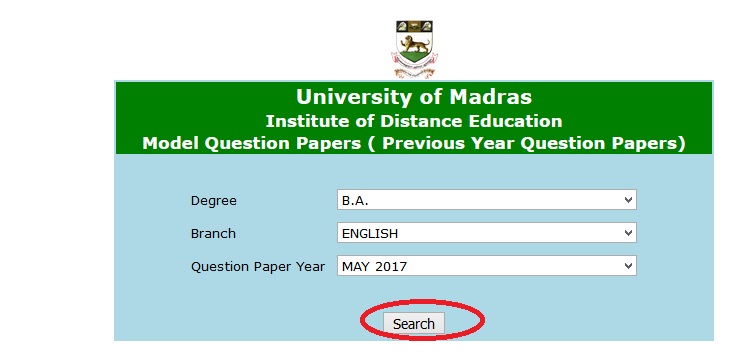Communication English-I & II B.A Question Paper : ideunom.ac.in
University : University of Madras
Degree : B.A
Department : English
Subject : Communication English-I & II
Document type : Question Paper
Website : ideunom.ac.in
Download Previous/ Old Question Paper :
English-I : https://www.pdfquestion.in/uploads/ideunom.ac.in/6885-_QBNEW1_uid31503%20ULJA%20UGLJA.pdf
English-II : https://www.pdfquestion.in/uploads/ideunom.ac.in/6885-2._QBNEW1_uid31504%20ULJB%20UGLJB.pdf
IDEUNOM English-I & II Question Paper
U/ID 31503/ULJA/
Time : Three hours
Maximum : 100 marks
SECTION A — (10 × 2 = 20 marks)
Answer any TEN questions in about 50 words each.
Related : University of Madras TRB English For Competitive Examination B.A Question Paper : www.pdfquestion.in/6884.html
MAY 2011
1. What are nasal sounds?
2. What are back vowels?
3. What are Group Discussion etiquettes?
4. What are the don’ts in a Group Discussion?
5. How far is dressing important in an interview?
6. What is speech apprehension?
7. What is the significance of quotations in compeering?
8. What is passive listening?
9. What makes listening difficult?
10. What kind of language is used in announcements?

11. What are the language aspects that you concentrate
12. What differences do you find in the accents ofwhile listening to news?
132. What differences do you find in the accents of native and non native speakers?
native and non native speakers?
SECTION B — (6 × 5 = 30 marks)
Answer any SIX of the following
in about 100 words each.
13. What sort of communication is expected in Group Discussion?
14. Write a note on English consonants.
15. Bring out the significance of social speech.
16. How can one prepare for a job interview?
17. Explain emotional intelligence.
18. Describe compeering a Radio programme.
19. What are the barriers to listening?
20. Discuss listening to Religious Speech.
21. Does listening to news improve one’s language? If so how?
22. What are diphthongs?
SECTION C — (5 × 10 = 50 marks)
Answer any FIVE of the following in about 200 words.
23. Write a note on the articulatory system in English.
24. Body language and posture effective in Public speaking – Justify.
25. How can one improve his or her pronunciation of English?
26. Bring out the differences between Indian accent and British accent.
27. Why is Group Discussion important in interview process?
28. What are the different types of interviews?
29. Describe effective listening.
30. How can listening skills be improved through announcements?
MAY 2012
U/ID 31504/ULJB/
UGLJB
Time : Three hours
Maximum : 100 marks
SECTION A — (10 ´ 2 = 20 marks)
Write short note on the following in about 50 words.
1. What are the mechanics of reading?
2. How can a good brochure contribute to marketing?
3. How do non news items receive attention?
4. What is an official language?
5. What kind of information can one gather from biographies?
6. What are the various steps that one is required
7. What guidelines can you give for the preparation of note – making?
8. What kind of Language is used in Advertisements?
9. What are the features of scientific writing?
10. How does visualising the reader help in writing letters?
SECTION B — (6 ´ 5 = 30 marks)
Answer any SIX of the following in about 200 words each.
11. How do skimming and scanning contribute to reading comprehension?
12. Discuss the style and language of scientific writing.
13. Discuss the nature of technical writing.
14. Bring out the important aspects of editorials.
15. How is a sentence classified?
16. What stylistic variations do you find between drama and fiction?
17. What are the uses of brochures?
18. What are the elements that make a good paragraph?
19. Discuss the basic principles of advertising.
20. Describe the important steps to be followed in note making.
21. The opening between the vocal cords is called ————————.
(a) The epiglottis
(b) The glottis
(c) The trechea
22. ———————— is a passive articulator.
(a) tongue
(b) lower lip
(c) upper lip
23. ———————— is voiceless labio-dental fricative sound.
(a) /h/
(b) /f/
(c) /t/
24. ———————— pure vowels in English.
(a) Tweleve
(b) Ten
(c) Fourteen
25. There are —————— diphthongs in English.
(a) 6
(b) 8
(c) 10
26. There are ———————— central vowels in English.
(a) two
(b) four
(c) three
27. Diphthongs is also called ————————
(a) vowel glides
(b) vowel friction
(c) consonant glides
28. / ¶ u/ is a ————————.
a) vowel
(b) dipthong
(c) consonant
29. ———————— sound is articulated with a structure of complete closure and sudden release.
(a) fricative
(b) plosive
(c) nasal
30. ———————— is articulated with a structure of complete oral closure.
(a) A plosive sound
(b) Nasal sound
(c) Fricative sound
31. The soft palate is also called ————————.
(a) velum
(b) larynx
(c) alveolar
32. Old English period dates from about ————————.
(a) 500 A.D. to 1000 A.D.
(b) 600 A.D. to 1100 A.D.
(c) 600 A.D. to 1000 A.D.